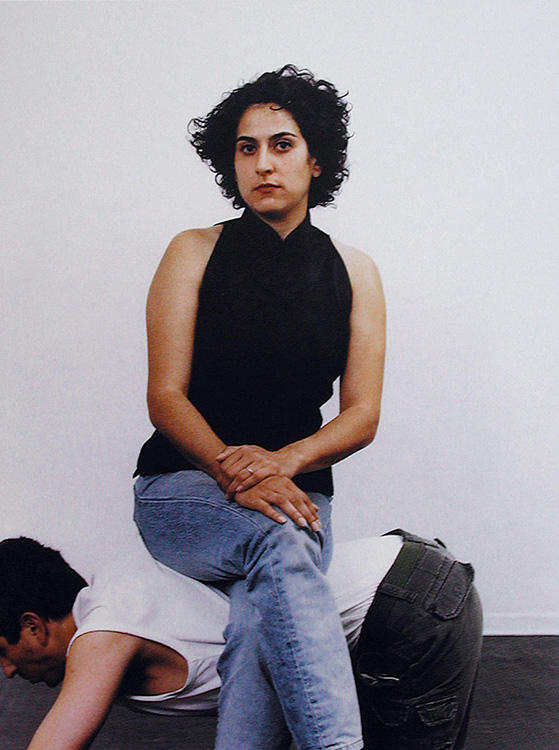
Sharjah
Sharjah Biennial
Various venues
April 6–June 6, 2005
Looking out from the balcony of my hotel room I see the city of Sharjah for the first time. The buildings are almost wholly made of glass. One looks upon them knowing well enough that they are constructed with materials that resist the workings of time. Although breakable, this glass is wrought and polished with extreme precision, made resistant to the persistent wear and tear of sandstorms. To miss the crucial fact that these buildings do little except seduce and lure us into caring for them is to misapprehend them; what they do is solicit our constant vigilance. Such is the situation from the hotel balcony. To know more one has to walk the spacious streets that cut through the city. Only then can one recognize the differences that distinguish each building: Each one is a unique object, and much can be said about the formal variations and range of glass ornamentation.
It is quite difficult when visiting Sharjah to avoid the mindset of a tourist; the city leaves one with little choice. One is often led to draw a general and generic image of the city, as the space seems to assume that a visitor is first and foremost a spectator. He eats and rests to prepare for another bout of Watching. Accordingly, the city is opaque, incessantly denigrating the other senses. We look at the glass and the reflections that glide on it but never at what’s behind it. A city that celebrates the frame: the frame of the dwelling and the shelter, but never that which is inside. In a sense, I am in a city spacious enough for all manner of exhibitionism. But never will you cross the limit of the glass. When in Sharjah, one is either a museum visitor or, alternatively, an image framed.
Museums are a solid reason for safeguarding cities. In this sense, Sharjah is a fragile and precious work that requires our consideration. It is a city that cannot withstand belligerence, a work of art made of streets, buildings and white air-conditioned cars. Everything in Sharjah partakes of the nature of museum except the museums themselves: a few measly documents, photographs and artifacts. Little of substance. And herein lies the truth that the history of Sharjah is stored in the memory and cameras of its visitors: It is the museum and we are in effect the photographers.
And yet it is a city that can surprise. In this case, it is the 7th International Biennial. Many recounted that during preparations, the janitors mistook a work of art for a pile of trash, took it to the dump and lost it. Such an incident raises a number of issues. Let us remind ourselves first that this biennial showcases works distinguished by transience, works that wipe away their traces with the end of the event. Before these works we must renew ourselves in order to see them with the eye of a shopper or a hotel guest. These works are without a memory. Yet they draw spectators closer to the evolving world. Whether one installation that seems to merely distribute ice cream to viewers or another that deals with issues of the public sphere, all works prompt the critical viewer into serious debates about so-called global issues. No longer a leisurely stroller looking for beauty in an expensive painting, the viewer must engage with the works in order to understand.
Accordingly, what is important is not the works themselves but rather the discussions they inspire; these discussions make the Biennial a “public time.” Perhaps it is necessary here to remind ourselves how, amid this globalization of ours, it is becoming increasingly difficult for us to enter public time. Globalization thrives in part on excluding a majority of people, on ignoring the needs of many while exacting of all places constant evidence of their camera worthiness. The Biennial is thus relevant inasmuch as it is capable of sustaining heated discussions, for it is in such discussions that the globalized calendar momentarily stops to include us in its contemporaneity, allowing us to be momentarily audible and visible.
And yet, some defenders of the classical arts persisted in considering the mishap of the janitors an indelible proof that these newer works are flippant, even unnecessary. That may be true — not only of newer works but also for all the safeguarded art treasures of the world. What is important is for us to remember that a biennial is an event limited in time. And so are the works. That is precisely their strength. When the next biennial arrives, other works will appear and with them other places and issues will arrive.
This Biennial, like any other, included some works which remained hidden well within the personalities of their makers. But these works did not attract any interest. The one element of the entire Biennial that remained curiously anachronistic was the insistence of Arab intellectuals and journalists, some of whom reside in the city, on criticizing these newer works. A curious situation indeed: On the one hand, the sheikhs and the local authorities showed a willingness to carry their city into the public time. On the other hand, intellectuals refused such an entry and doubted its relevance. What we witness is truly a reversal, for when the Sovereign calls for openness and intellectuals cower, one is tempted to view the entire picture anew, starting from the back — from the side that lies hidden behind the glass window.